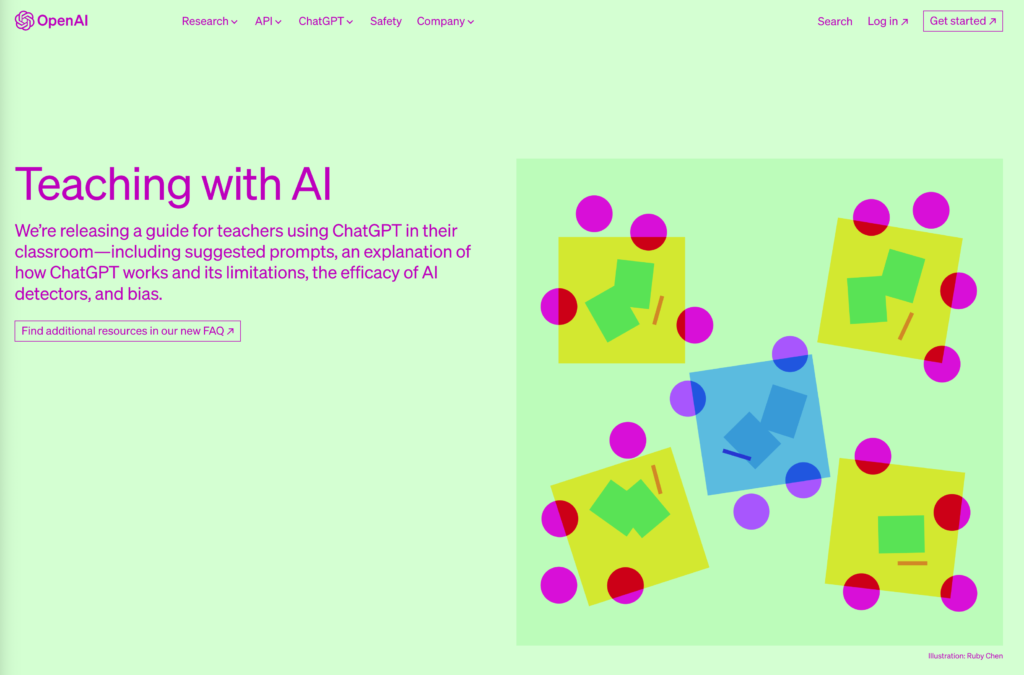
Amidst the transformative wave of teaching with AI, the educational landscape is evolving rapidly, with artificial intelligence (AI) tools like ChatGPT assuming an increasingly vital role. OpenAI, a pioneering AI research organization, has astutely acknowledged ChatGPT’s immense potential in education. Their recent release on August 31, 2023, vividly illustrates how educators are harnessing this powerful AI tool to reshape the learning experience. This educational paradigm shift towards AI is also echoed in the changing attitudes among school districts and educators. Let’s delve into the pivotal role ChatGPT now occupies in modern classrooms, reflecting the broader acceptance of AI’s potential in education.
In a noteworthy development, many school districts are reevaluating their stance on ChatGPT and AI tools in the classroom. Earlier this year, some schools had taken a cautious approach, choosing to ban ChatGPT. However, the educational landscape is evolving rapidly, and these institutions are now in the process of reconsidering their policies. This shift reflects a growing realization that AI is not just a novelty but is becoming an integral and transformative part of modern education.
This transformation is underscored by a recent survey conducted by EdWeek, which revealed a compelling statistic: more than 70% of teachers believe that teaching students how to use AI tools is at least somewhat important. This significant majority underscores the rapidly growing recognition among educators of AI’s relevance and its potential to enhance the learning process. It’s a clear indicator that the education sector is increasingly embracing AI as a valuable educational resource, and ChatGPT is at the forefront of this transformative wave.
OpenAI’s Teaching with AI Guide
Capitalizing on this shift towards AI acceptance in education, OpenAI released a comprehensive “Teaching with AI” guide for teachers. This guide equips educators with valuable insights into the versatile applications of ChatGPT in the classroom.
Four Key Use Cases for ChatGPT:
OpenAI’s guide highlights four primary ways in which teachers are effectively utilizing ChatGPT:
- Role-playing Challenging Conversations: Dr. Helen Crompton, a professor at Old Dominion University, recommends using ChatGPT to simulate various personas, enabling students to engage in nuanced and insightful conversations. This approach enriches their understanding of complex topics.
- Building Quizzes, Tests, and Lesson Plans: Fran Bellas, a professor at Universidade da Coruña, suggests that ChatGPT can serve as an invaluable assistant in crafting quizzes, exams, and lesson plans. By integrating modern and culturally relevant examples, teachers can enhance their teaching materials.
- Reducing Friction for Non-English Speakers: Dr Anthony Kaziboni, Head of Research at the University of Johannesburg, advocates for the use of ChatGPT to assist non-English-speaking students with translation, English writing improvement, and conversation practice, thereby levelling the playing field.
- Teaching Critical Thinking: Geetha Venugopal, a high school computer science teacher in India, likens teaching with ChatGPT to imparting responsible internet use skills. Students are encouraged to critically evaluate ChatGPT’s responses, fostering their original critical thinking, problem-solving, and creativity skills.
Practical Prompts for Educators
OpenAI’s guide offers educators a valuable toolkit of prompts categorized into four types. These prompts serve as powerful tools to maximize the potential of ChatGPT in the classroom. Educators can utilize them to:
- Craft Comprehensive Lesson Plans: These prompts assist in creating well-rounded lesson plans that incorporate various teaching techniques, ensuring an engaging learning experience for students.
- Clarify Complex Concepts: Educators can rely on ChatGPT to simplify intricate ideas into clear and accessible explanations, enhancing students’ comprehension.
- Empower AI Tutoring: Transforming ChatGPT into an AI tutor, these prompts encourage students to seek explanations, fostering independent learning while providing guidance.
- Encourage Interactive Learning: The prompts promote interactive learning experiences, where students actively participate, think critically, and receive constructive feedback.
Incorporating these prompts into their teaching strategies, educators can tap into the full potential of AI-enhanced education, creating dynamic and effective learning environments for students.
A Resource for Parents and Students
OpenAI’s guide not only caters to educators but also extends a welcoming hand to parents and students who are enthusiastic about delving into the realm of AI in education. For those eager to explore this exciting frontier, the guide serves as an invaluable starting point.
The guide illuminates the path toward harnessing AI’s potential, with a particular focus on ChatGPT’s role as a learning resource. It offers a roadmap for students and parents to understand how AI can be integrated into the educational journey. This includes:
- Understanding AI’s Versatility: The guide provides insights into the versatile applications of AI, showcasing how ChatGPT can be employed to support learning across various subjects and levels.
- Enhancing Problem-Solving Skills: It demonstrates how AI can be used not only to provide answers but also to stimulate critical thinking. Students can engage with ChatGPT to explore solutions collaboratively, honing their problem-solving abilities.
- Access to a Wealth of Information: ChatGPT opens doors to a vast repository of knowledge, making it a valuable research companion for students seeking information and guidance on various topics.
- Promoting Self-Directed Learning: By empowering students to interact with AI, the guide encourages self-directed learning. Students can explore, question, and expand their knowledge independently.
As AI continues to reshape the landscape of education, OpenAI’s guide acts as a bridge between traditional learning and the future of education. It instils the idea that AI, particularly ChatGPT, is not merely a tool but a resource that can enrich the learning experience, making it engaging, interactive, and tailored to individual needs.
Conclusion
In an era where AI continues to reshape the educational landscape, OpenAI’s unwavering dedication to providing invaluable resources for educators is readily apparent. ChatGPT’s remarkable versatility in facilitating critical thinking and promoting interactive learning has positioned it as an invaluable asset in today’s modern classrooms.
With school districts increasingly accepting AI tools, the horizon of education appears more dynamic and AI-integrated than ever before. This evolution heralds a future where AI becomes an integral part of the learning experience, enriching education in ways previously unimagined.
For parents and students, OpenAI’s guide serves as an illuminating introduction to the exciting possibilities that AI presents in the realm of learning. It offers insights into how AI can revolutionize the way we acquire knowledge, engage with educational content, and nurture critical thinking skills. In this rapidly evolving educational landscape, the guide acts as a beacon, guiding learners toward a future where AI-driven learning promises to be both empowering and transformative.

